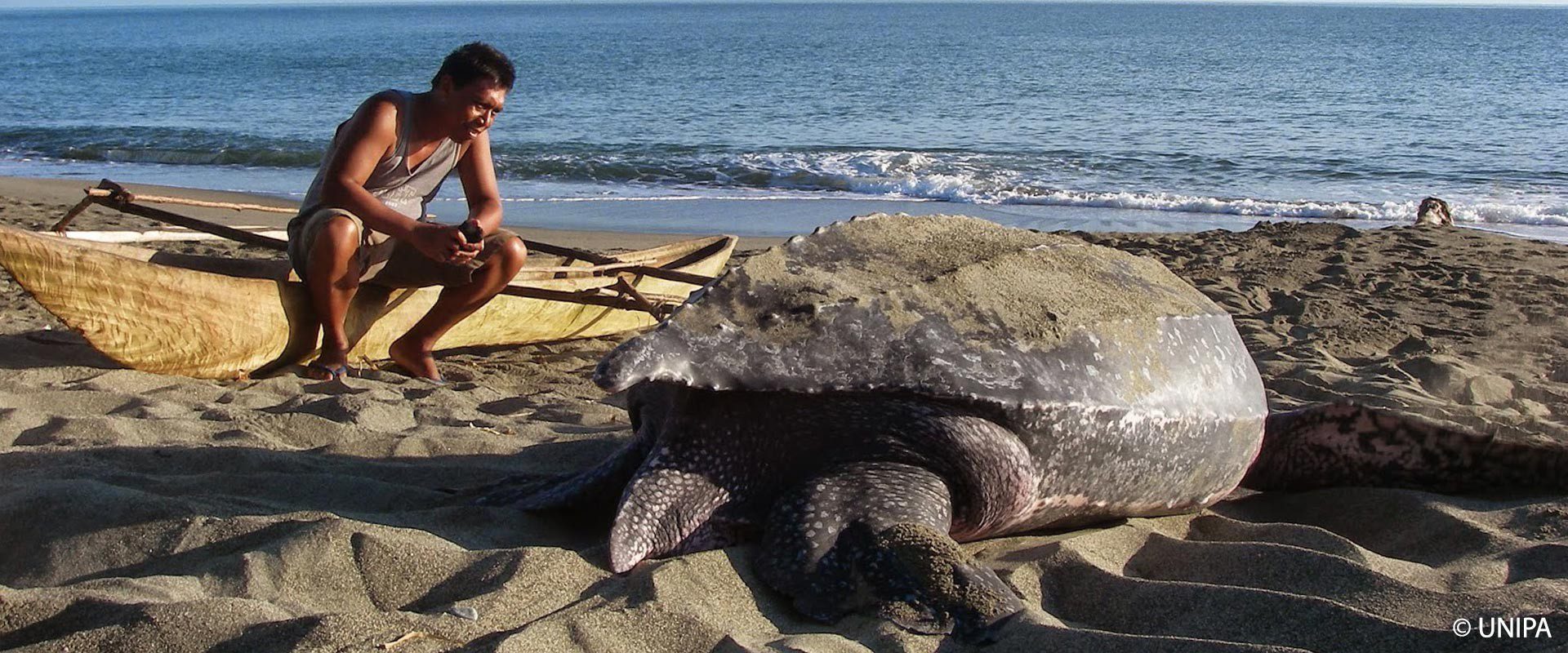Saving the last stronghold of the Pacific leatherback
Saving the last stronghold of the Pacific leatherback
This post is one of a series on projects supported by the Aquarium’s Marine Conservation Action Fund (MCAF). Through MCAF, the Aquarium supports researchers, conservationists and grassroots organizations all around the world as they work to address the most challenging problems facing the ocean.
To view the original post click, here.
Ricardo F. Tapilatu, who is a faculty member of the Pacific Marine Resources Research Center at the University of Papua, Manokwari, Papua Barat Province in Indonesia, writes this post. Tapilatu’s Bird’s Head Leatherback Conservation Program received an MCAF grant in 2013 and is also featured in the IMAX movie Journey to the South Pacific, now showing at the New England Aquarium’s Simons IMAX Theatre.
Leatherback turtles are widely distributed throughout the Atlantic, Pacific and Indian oceans. Although nesting occurs in subtropical and tropical latitudes, many leatherbacks migrate long distances to forage in cool and productive high latitude waters. Some of the longest migrations are undertaken by western Pacific leatherbacks, from the northwest coast of West Papua, Indonesia, to the West Coast of the United States; a yearlong journey of more than 6,000 miles! Western Pacific leatherback turtles nest in Indonesia, Papua New Guinea and the Solomon Islands. The Bird’s Head region of New Guinea in West Papua, Indonesia, is unique. Unlike other leatherback rookeries in the world, nesting in the region occurs year-round. Some nest between April and September (boreal or Northern Hemisphere summer), and others between October and March (austral or Southern Hemisphere summer).
 |
| Ricardo Tapilatu and his team work to ensure the safety of tiny leatherback hatchlings and the future health of leatherback turtle populations. Photo: UNIPA |
Tracking their movements using satellites revealed that during boreal summer, Bird’s Head leatherbacks undertake epic migrations to Northern Hemisphere foraging destinations in the South China Sea, central North Pacific and California Current Ecosystem off the West Coast of U.S., whereas those that nest during austral summer migrate to the Southern Hemisphere of the south Indonesian seas, East Australian Current extension and Tasman Front. The separation in migrating and foraging in these distinct regions leads to variation in body size and breeding frequency within the population, which consists of two demographically distinct groups.
| Tapilatu watches a leatherback turtle return to the sea after laying her eggs. Photo: UNIPA |
The Bird’s Head region is the last stronghold for leatherbacks in the western Pacific. Aerial surveys throughout the whole nesting range revealed that 75 percent of nesting activity every year occurs in Bird’s Head, at Jamursba Medi and Wermon beaches. The population, however, has been declining rapidly, at approximately 5.9 percent per year. Number of nests has been reduced by 78.3 percent in Jamursba Medi and 62.8 percent in Wermon since 1984, and only 500 females are estimated to nest in this region annually. Because of this, conservation in this region is a great priority.
 |
| Western Pacific leatherback nesting has declined dramatically in recent years at two key beaches in Indonesia. Photo: UNIPA |
Over the last decade, leatherback conservation led by the State University of Papua (UNIPA) has been focusing on protecting nesting leatherbacks and maximizing hatchling production at Jamursba Medi and Wermon. Major threats to nest survival include predation by pigs and dogs, tidal inundation, erosion and extreme beach temperatures, which results in female-biased sex ratio. To improve hatching success, nests were protected using multiple methods: 1) shading in areas where extreme sand temperatures have been recorded, 2) enclosures in areas with great pig or dog predation risk, 3) a combination of shading and enclosures, and 4) relocating nests that were laid in areas below the high water mark. These protections have been in place for several years and have been shown to greatly improve hatching success.
UNIPA partners with surrounding communities, federal and local governments and other non-governmental organizations. Through long-term protection program supported by local stakeholders, there is hope for western Pacific leatherbacks.





































